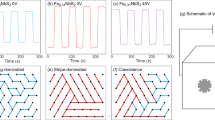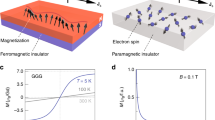Abstract
Johnson suggests that our results1 are not due to spin transport but rather are caused by spurious effects, in particular the anisotropic magneto resistance of the ferromagnetic contacts. However, our experiment was designed explicitly to eliminate any magneto-resistance effects that might arise from the ferromagnetic contacts.
Similar content being viewed by others
Jedema et al. reply
We used the well known principle of four-terminal measurement. No current flows through the ferromagnetic detector contact, so its (magneto) resistance does not affect the measurement. Similarly, the (magneto) resistance of the ferromagnetic injector contact is not relevant, because any voltage that develops across it will not affect the current that is sent through it. The only region that could then possibly give rise to a (magneto) resistance is the central part of the copper cross, but explicit measurements confirm that this region does not produce any magneto resistance. So, having eliminated all other possible contributions, the only mechanism left that can give rise to a signal is spin accumulation. In view of this, and of the consistency of our measurements and analysis1,2, the suggestion that we cannot distinguish between spin accumulation and anisotropic magneto resistance is unjustified.
Johnson also points out that if we have observed spin accumulation, then our conclusion that the spin polarization of the current is low (1–2%) must be wrong —claiming that it should be considerably higher (around 40%). Our detailed theoretical model2 reveals that our conclusion does not crucially depend on specific details of the injection mechanism. Moreover, we did not invoke conductivity mismatch3. It is an integral part of the description, in which the boundary conditions imposed by the contacts are included in a straightforward way.
Consistent treatment of the injector and detector contacts4,5 is missing from Johnson's description, which therefore cannot be applied directly to the case of transparent contacts. Moreover, we did not observe any interface resistance between ferromagnetic and non-magnetic regions, as Johnson suggests, which could be distinguished from the bulk diffusive resistance. There is also no physical reason why there should be such a large resistance at a (disordered) interface between metals.
Our experiments enabled us to observe spin accumulation in its purest form, without any contribution from spurious effects. The low spin polarization of the injected current can be explained by proper modelling of the entire system, including the contacts.
References
Jedema, F. J., Filip, A. T. & van Wees, B. J. Nature 410, 345–348 (2001).
Jedema, F. J., Nijboer, M. S., Filip, A. T. & van Wees, B. J. J. Supercond. 15, 27–35 (2002).
Schmidt, G., Ferrand, D., Molenkamp, L., Filip, A. T. & van Wees, B. J. Phys. Rev. B 62, R4790 (2000).
Fert, A. & Lee, S. F. Phys. Rev. B 53, 6554–6565 (1996).
Herschenfield, S. & Zhao, L. Z. Phys. Rev. B 56, 3296–3305 (1997).
Author information
Authors and Affiliations
Corresponding author
Additional information
brief communications is intended to provide a forum for both brief, topical reports of general scientific interest and technical discussion of recently published material of particular interest to non-specialist readers. Priority will be given to contributions that have fewer than 500 words, 10 references and only one figure. Detailed guidelines are available on Nature's website (http://www.nature.com) or on request from nature@nature.com
Rights and permissions
About this article
Cite this article
Jedema, F., Filip, A. & van Wees, B. Spin accumulation in mesoscopic systems. Nature 416, 810 (2002). https://doi.org/10.1038/416810a
Issue Date:
DOI: https://doi.org/10.1038/416810a
This article is cited by
-
On the Formation of Nanostructures from Stilbazolium-like Dyes
Journal of Nanoparticle Research (2006)
Comments
By submitting a comment you agree to abide by our Terms and Community Guidelines. If you find something abusive or that does not comply with our terms or guidelines please flag it as inappropriate.



